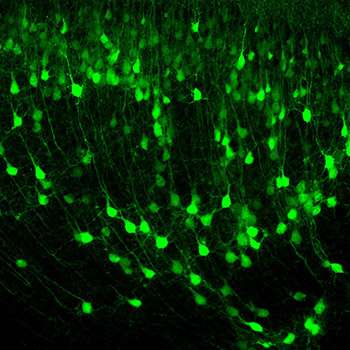Neurons stained in green are misshapen and misplaced in some cases of epilepsy. Credit: Yale University
Cortical malformations are a major cause of epileptic seizures and are a hallmark feature of many neurodevelopmental disorders. Expanding upon its recently-published model of cortical malformations, a Yale team lead by neuroscientist Angelique Bordey identified a molecular target that is critical in generating many of the cellular abnormalities seen in this condition.
Restoring normal signaling through a major regulator of protein synthesis — eIF4E binding protein (4E-BP)—prevented the abnormal positioning, growth, and connectivity of disordered neurons. These findings highlight 4E-BP signaling as a potential drug target in the treatment of seizures and neurological impairments associated with cortical malformations.
The research is published in the Proceedings of the National Academy of Sciences and is available Sept. 19.
More information: Tiffany V. Lin et al. Normalizing translation through 4E-BP prevents mTOR-driven cortical mislamination and ameliorates aberrant neuron integration, Proceedings of the National Academy of Sciences (2016). DOI: 10.1073/pnas.1605740113
Journal information: Proceedings of the National Academy of Sciences
Provided by Yale University






















